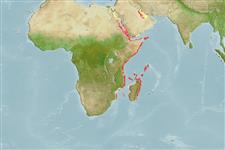Common names from other countries
Classification / Names / Names
Namen | Synonyme | Catalog of Fishes (gen., sp.) | ITIS | CoL | WoRMS
Environment: milieu / climate zone / depth range / distribution range
Ökologie
; tiefenbereich 0 - 30 m (Ref. 847). Tropical; 30°N - 25°S, 32°E - 55°E (Ref. 847)
Western Indian Ocean: Red Sea, Gulf of Aden, Somalia Coastal Current and Madagascar.
Length at first maturity / Size / Gewicht / Alter
Maturity: Lm ? range ? - ? cm Max length : 4.0 cm BRW Männchen/unbestimmt; (Ref. 847)
Colonies are usually clumps of short knobby branches up to 40 mm thick with blunt ends. Corallites are crowded and immersed to conical with hoods facing different directions. Uniform cream in color.
Life cycle and mating behavior
Geschlechtsreife | Fortpflanzung | Ablaichen | Eier | Fecundity | Larven
Members of the class Anthozoa are either gonochoric or hermaphroditic. Mature gametes are shed into the coelenteron and spawned through the mouth. Life cycle: The zygote develops into a planktonic planula larva. Metamorphosis begins with early morphogenesis of tentacles, septa and pharynx before larval settlement on the aboral end.
Veron, J.E.N. 2000. (Ref. 847)
IUCN Rote Liste Status (Ref. 130435)
CITES Status (Ref. 108899)
Not Evaluated
Nutzung durch Menschen
| FishSource |
Tools
Mehr Information
Alter/GrößeWachstumLänge-GewichtLänge-LängeMorphologieLarvenDichte
Internet Quellen
Estimates based on models
Preferred temperature
(Ref.
115969): 25.6 - 29.2, mean 27.5 (based on 421 cells).
Verwundbarkeit
Low vulnerability (10 of 100).
Preiskategorie
Unknown.
